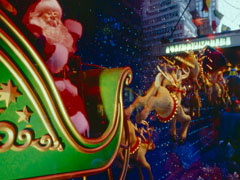The Real Story of Christmas
World Traditions
Evolution of Santa
- The Legend of St. Nicholas
- Sinter Klass Comes to New York
- Shopping Mall Santas
- 'Twas the Night Before Christmas
- A Santa By Any Other Name
- The Ninth Reindeer
Christmas Trees
Kwanza
Hanukkah |
'Twas the Night Before Christmas
In 1822, Clement Clarke Moore, an Episcopal minister, wrote a long Christmas poem for his three daughters entitled, "An Account of a Visit from St. Nicholas." Moore's poem, which he was initially hesitant to publish due to the frivolous nature of its subject, is largely responsible for our modern image of Santa Claus as a "right jolly old elf" with a portly figure and the supernatural ability to ascend a chimney with a mere nod of his head! Although some of Moore's imagery was probably borrowed from other sources, his poem helped to popularize Christmas Eve – Santa Claus waiting for the children to get to sleep the now-familiar idea of a Santa Claus who flew from house to house on Christmas Eve – in "a miniature sleigh" led by eight flying reindeer, whom he also named – leaving presents for deserving children. "An Account of a Visit from St. Nicholas," created a new and immediately popular American icon. In 1881, political cartoonist Thomas Nast drew on Moore's poem to create the first likeness that matches our modern image of Santa Claus. His cartoon, which appeared in Harper's Weekly, depicted Santa as a rotund, cheerful man with a full, white beard, holding a sack laden with toys for lucky children. It is Nast who gave Santa his bright red suit trimmed with white fur, North Pole workshop, elves, and his wife, Mrs. Claus. three daughters entitled, "An Account of a Visit from St. Nicholas." Moore's poem, which he was initially hesitant to publish due to the frivolous nature of its subject, is largely responsible for our modern image of Santa Claus as a "right jolly old elf" with a portly figure and the supernatural ability to ascend a chimney with a mere nod of his head! Although some of Moore's imagery was probably borrowed from other sources, his poem helped to popularize Christmas Eve – Santa Claus waiting for the children to get to sleep the now-familiar idea of a Santa Claus who flew from house to house on Christmas Eve – in "a miniature sleigh" led by eight flying reindeer, whom he also named – leaving presents for deserving children. "An Account of a Visit from St. Nicholas," created a new and immediately popular American icon. In 1881, political cartoonist Thomas Nast drew on Moore's poem to create the first likeness that matches our modern image of Santa Claus. His cartoon, which appeared in Harper's Weekly, depicted Santa as a rotund, cheerful man with a full, white beard, holding a sack laden with toys for lucky children. It is Nast who gave Santa his bright red suit trimmed with white fur, North Pole workshop, elves, and his wife, Mrs. Claus.
Next Page: A Santa by Any Other Name
|

 three daughters entitled, "An Account of a Visit from St. Nicholas." Moore's poem, which he was initially hesitant to publish due to the frivolous nature of its subject, is largely responsible for our modern image of Santa Claus as a "right jolly old elf" with a portly figure and the supernatural ability to ascend a chimney with a mere nod of his head! Although some of Moore's imagery was probably borrowed from other sources, his poem helped to popularize Christmas Eve – Santa Claus waiting for the children to get to sleep the now-familiar idea of a Santa Claus who flew from house to house on Christmas Eve – in "a miniature sleigh" led by eight flying reindeer, whom he also named – leaving presents for deserving children. "An Account of a Visit from St. Nicholas," created a new and immediately popular American icon. In 1881, political cartoonist Thomas Nast drew on Moore's poem to create the first likeness that matches our modern image of Santa Claus. His cartoon, which appeared in Harper's Weekly, depicted Santa as a rotund, cheerful man with a full, white beard, holding a sack laden with toys for lucky children. It is Nast who gave Santa his bright red suit trimmed with white fur, North Pole workshop, elves, and his wife, Mrs. Claus.
three daughters entitled, "An Account of a Visit from St. Nicholas." Moore's poem, which he was initially hesitant to publish due to the frivolous nature of its subject, is largely responsible for our modern image of Santa Claus as a "right jolly old elf" with a portly figure and the supernatural ability to ascend a chimney with a mere nod of his head! Although some of Moore's imagery was probably borrowed from other sources, his poem helped to popularize Christmas Eve – Santa Claus waiting for the children to get to sleep the now-familiar idea of a Santa Claus who flew from house to house on Christmas Eve – in "a miniature sleigh" led by eight flying reindeer, whom he also named – leaving presents for deserving children. "An Account of a Visit from St. Nicholas," created a new and immediately popular American icon. In 1881, political cartoonist Thomas Nast drew on Moore's poem to create the first likeness that matches our modern image of Santa Claus. His cartoon, which appeared in Harper's Weekly, depicted Santa as a rotund, cheerful man with a full, white beard, holding a sack laden with toys for lucky children. It is Nast who gave Santa his bright red suit trimmed with white fur, North Pole workshop, elves, and his wife, Mrs. Claus.